Skills NOT to Teach
Young Athletes
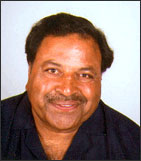
For more coaching information, visit www.coachshiv.com
| January | February | March |
|
April | May | June |
|  |
|||||
| July | August | September | October | November | December | |
![]()
INTRODUCTION
Hockey is changing and evolving every year. With the good comes the bad. We human beings tend to have a mob mentality, and in many cases we imitate the latest trends in the sport without even being aware of its negative consequences.
We as coaches usually focus on "what to do" and avoid paying attention to "what NOT to do". The aim of this article is to show that knowing "what NOT to coach" is as important as knowing "what to coach".
Just as we keep our kids away from bad company, knowing that it is better to be alone rather than in bad company, in the same way, there are skills which need to be avoided and discouraged, at all cost.
There are 5 such skills we will focus on - we start with "Stance". A player's stance plays a huge role in developing the athlete into a fluid hockey player who does everything on the run, as opposed to being an athlete who plays static or semi-static hockey. The former style is more graceful and effective than the later. Let's cover the key points of the stance.
WHAT IS A CORRECT STANCE?
According to Webster's new collegiate dictionary, "Stance is the position of both body and feet from which an athlete starts or operates".
The first step to consider in the development of a young hockey player is to observe his (her) stance. How does he stand? Are his feet too close or too far? Are his knees flexed or not? Is his upper body low or not? And to what degree do these observations match the optimum stance the coach has in his mind?
3 case studies displaying contrasting stances are shown below. Please observe and compare the photographs, especially the feet and the stick angles.
Note that the way the player holds the stick, the angle at which it is held, and how the stick shifts from hand to hand also matter. However, this merits a separate article in itself.
| Player-on-Toes Stance |
The advantages of a Player-on-Toes stance are as follows:
| Photograph 1: Player-on-Toes Stance |
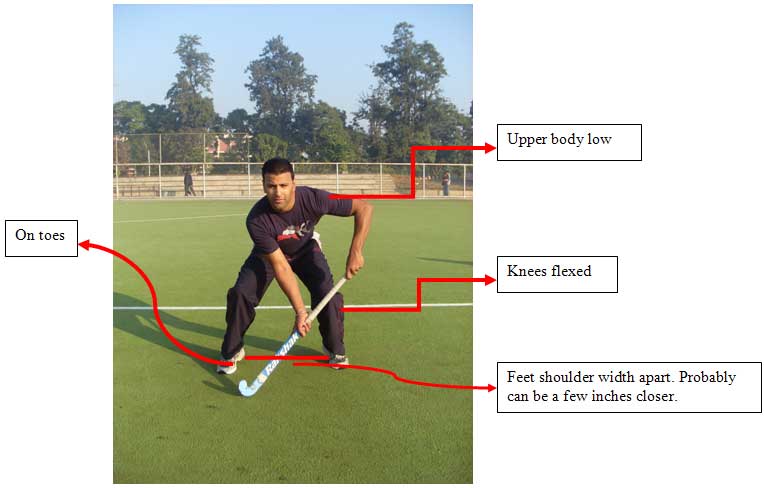 |
| Stick-on-Ground Stance |
The concept of the flat-footed stance, with the stick held flat on the ground, was a byproduct of Indoor hockey played by the Germans during their winter season. It became popular in the late 1990s.
While the flat-footed concept is effective in the indoor game, due to the smaller size of the field and indoor-specific rules, this stance does have limitations in the outdoor game.
In the Stick-on-Ground stance, it will be hard to react to the ball when passed on the either side of the defender's foot, especially on his left foot. The photograph below is from a match situation between Spain and Malaysia during the 2000 Sydney Olympics.
| Photograph 2: Stick-on-Ground Stance |
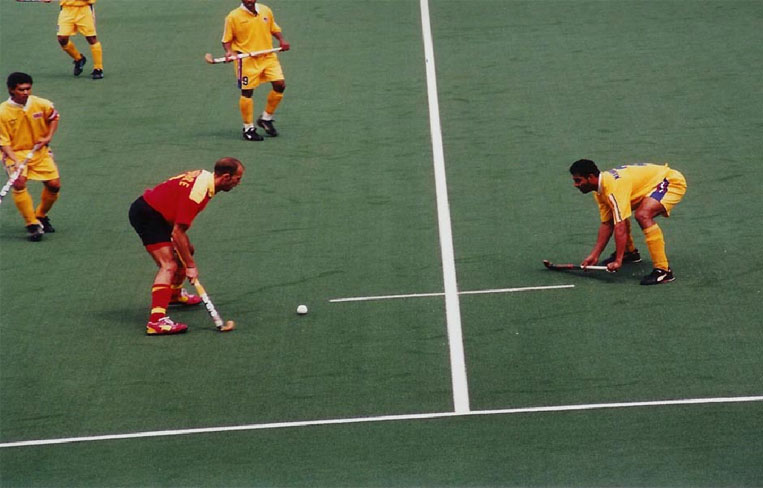 |
| Unbalanced Stance and its Impact |
This sequence of photographs (courtesy NBC) is from the semi-final match between Germany and Netherlands in the 2008 Beijing Olympic Games. Netherlands was leading 1-0, with less than 3 minutes to go. Germany scored the equaliser in the final 3 minutes, and then went on to win the penalty shoot-out to enter the Olympic hockey final.
While several factors came into play to enable the equalising goal, we will focus specifically on the role Netherland players' unbalanced stance played in this critical game situation.
In the 67th minute, Scottish-turned-Dutch player Laurence Docherty (# 11), was penalized for a foul in between his defending circle and the 23 metre line. While defending the free hit, he and some of his teammates had an unbalanced stance, with the stick not being at an optimum angle. This was one of the factors that aided the German players in their attempt to score the equalising field goal.
| Photograph 3 - Unbalanced Stance and its Impact |
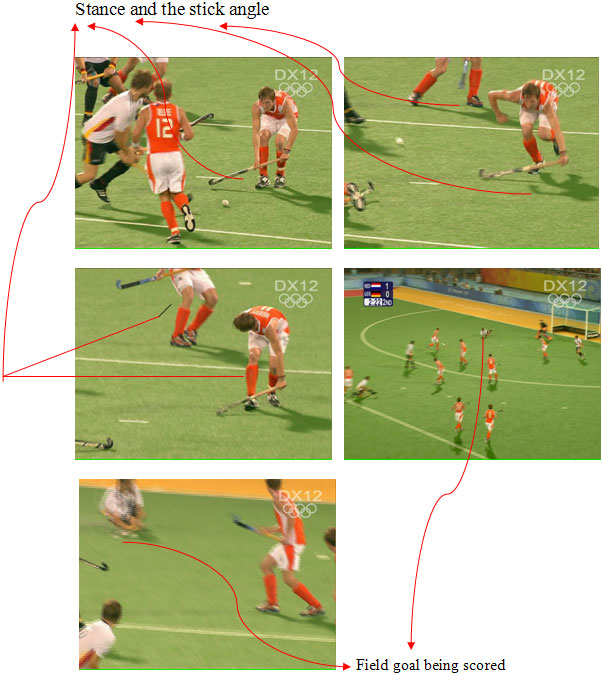 |
CONCLUSION
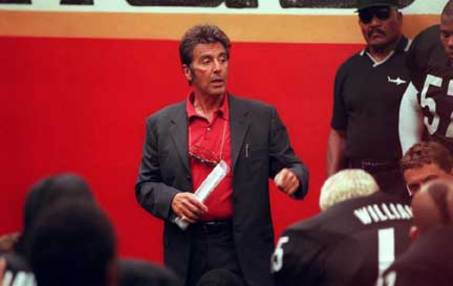
Al Pacino as coach giving a pep talk in the movie 'Any Given Sunday'
An unbalanced stance, just like inches on the ground and seconds on the clock, can make the difference between winning and losing.
To drive home this point, I would like to conclude with the pep talk given by Al Pacino, playing the role of an (American) football coach in the movie "Any Given Sunday".
"You find out life's this game of inches, so is football. Because in either game - Life or Football - the margin for error is so small.
I mean, one half step too late or too early, and you don't quite make it. One half second too slow or too fast, and you don't quite catch it.
The inches we need are everywhere around us. They're in every break of the game, every minute, every second.
On this team, we fight for that inch. On this team, we tear ourselves and everyone else around us to pieces for that inch. We claw with our fingernails for that inch.
Because we know when add up all those inches, that's gonna make all the difference between winning and losing. Between living and dying!"
![]()